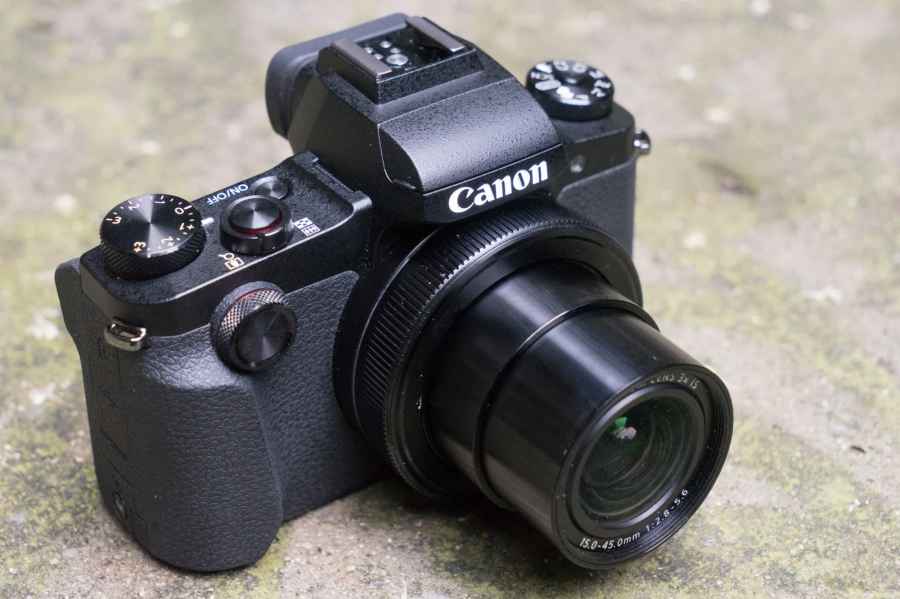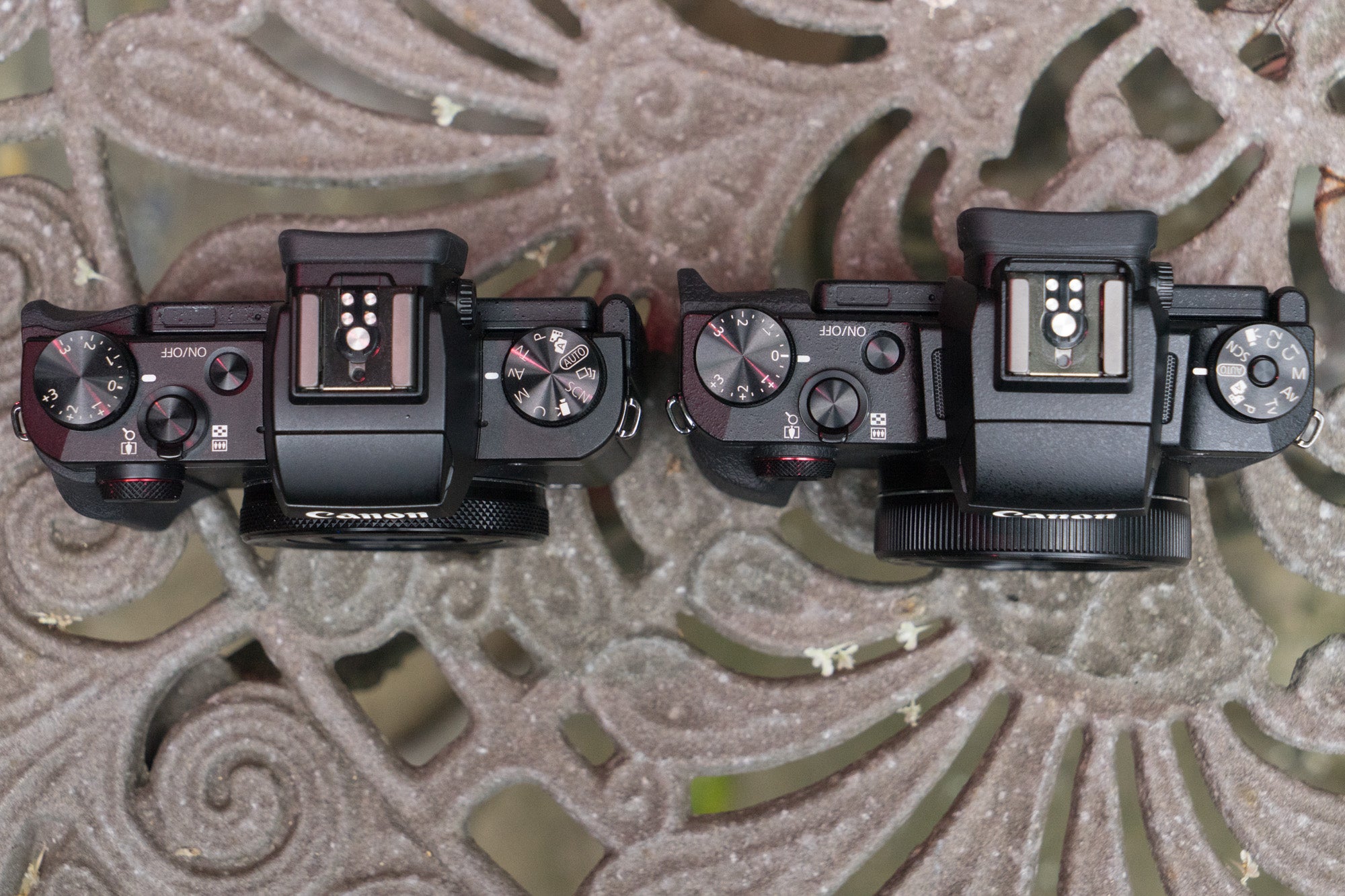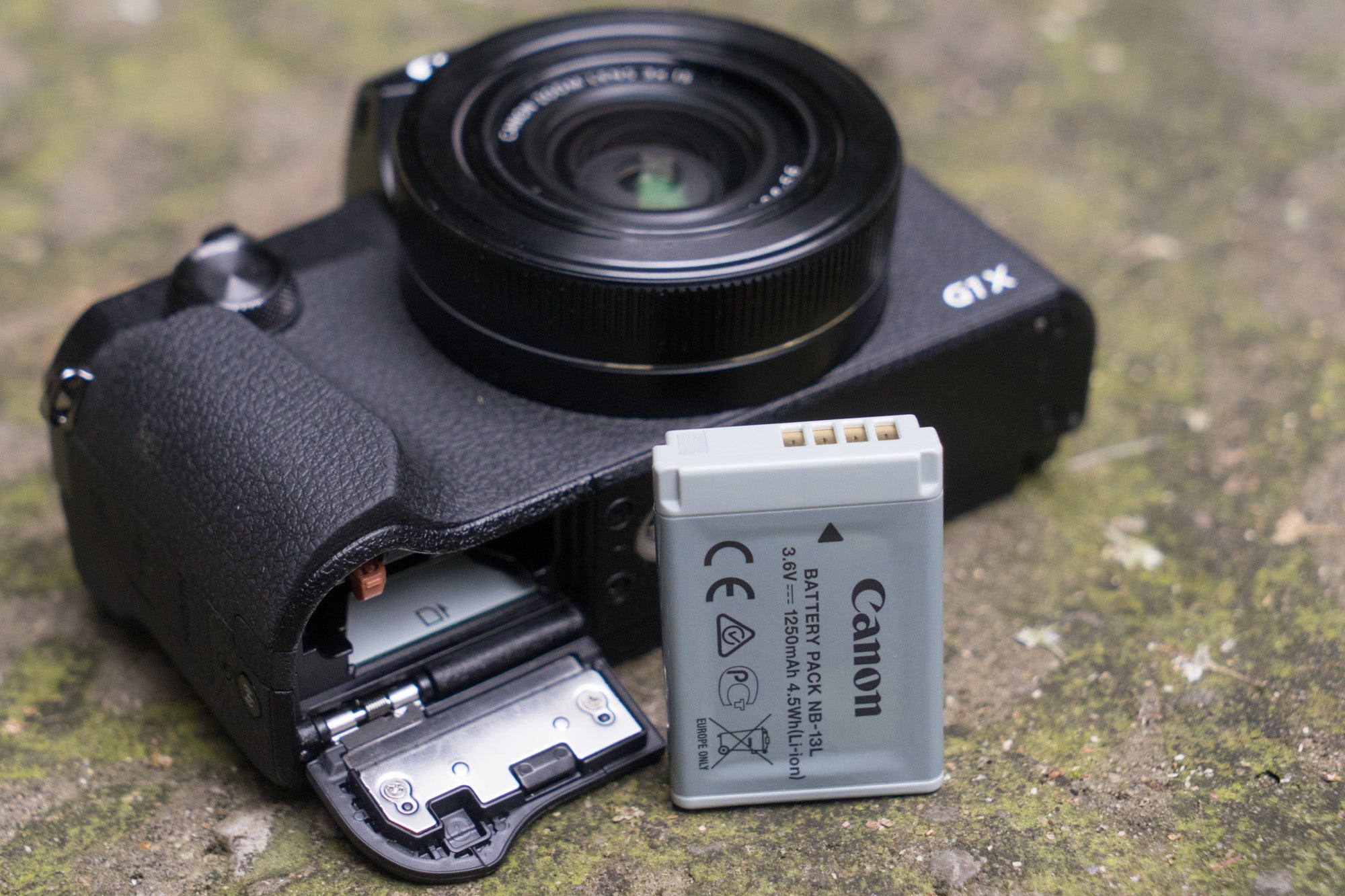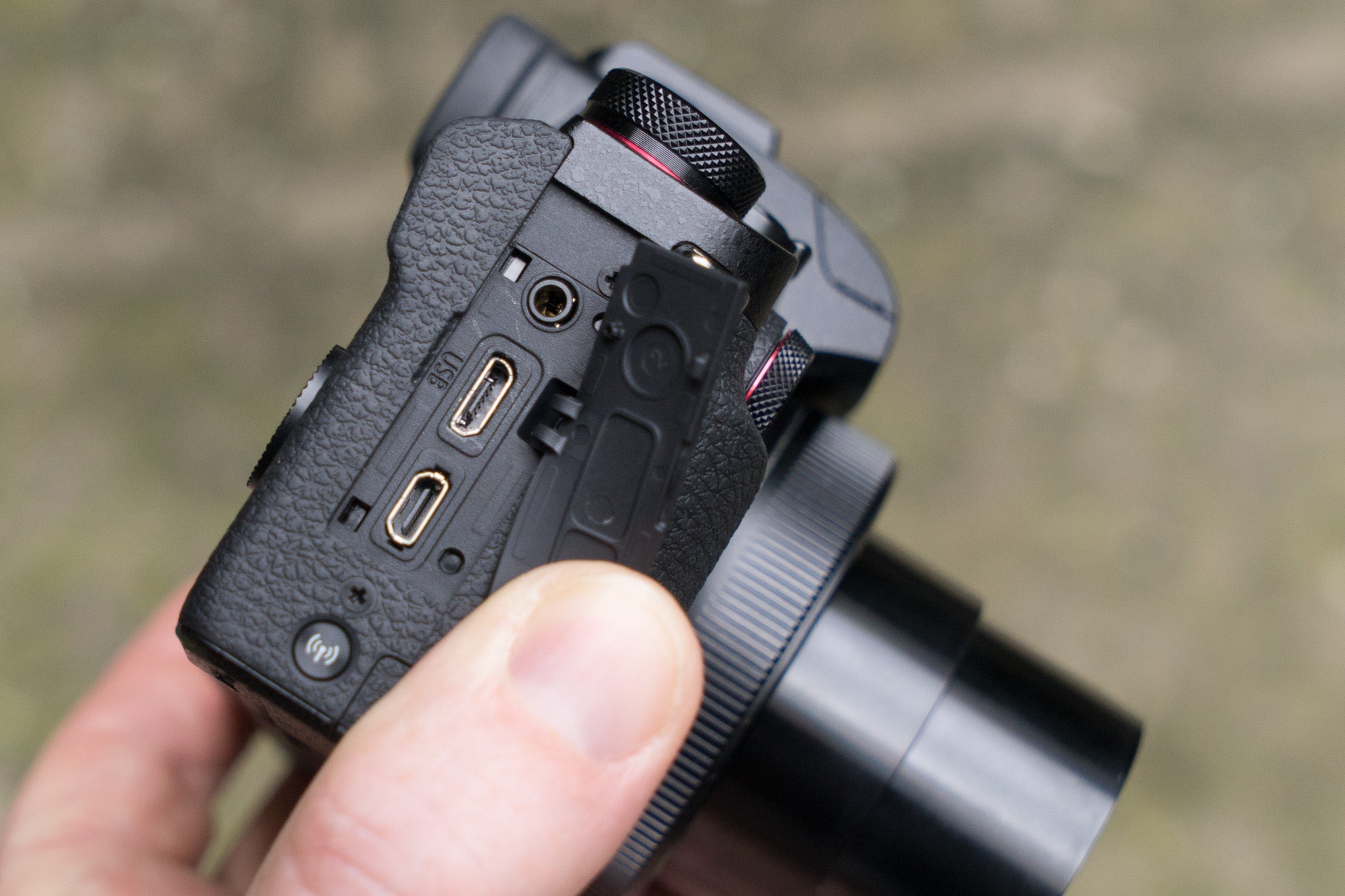Canon PowerShot G1 X Mark III at a glance
- £1,149 (body only)
- 24.2MP APS-C sensor
- ISO 100-25,600
- 24-72mm (equiv) f/2.8-5.6 lens
- 2.36M dot OLED EVF
- 3in articulated touchscreen
In the early days of digital, Canon’s PowerShot G-series compacts were hugely popular with enthusiast photographers for their combination of decent image quality and extensive manual controls. Canon was also the first in early 2012 to put a large sensor into a reasonably small zoom compact, with its original PowerShot G1X sporting a 14-megapixel, 1.5-inch sensor.
However, less than six months later Sony released its pocket-sized Cyber-shot RX100 with a 20-megapixel 1-inch sensor, and the competition has been playing catch-up ever since. Canon’s follow-up G1X Mark II never quite caught the imagination, with a bulky design that lacked a built-in viewfinder.
Now, though, Canon has upped the ante considerably, by placing a 24-megapixel APS-C sensor into a remarkably compact body. In principle, this means the G1X Mark III should offer better image quality than any other zoom compact on the market, and the equal of many DSLRs.
The new model also eschews the uninspired boxy designs of its predecessors, and is instead based on the SLR-like PowerShot G5X, with a central built-in electronic viewfinder and fully articulated touchscreen. As a result, it promises a rare marriage between compact size, high image quality and usability.
Naturally, there are some compromises to be made for this feat of miniaturisation. The most obvious is the lens: its 24-72mm equivalent range and f/2.8-5.6 maximum aperture look limited compared to either its G1X-series predecessors, or the 24-100mm equivalent f/1.8-2.8 zoom on the G5X and G7X Mark II. Its 200-shots-per-charge stamina is also well below par, but at least the NB-13L battery is shared with many recent PowerShot models, making spares easy to find.
Last but not least, the £1149 price tag places the camera firmly into the realm of serious photographers.
This isn’t actually the first camera to combine an APS-C sensor with a built-in zoom lens, having been preceded by Sony’s bridge-type Cyber-shot DSC-R1 in 2005, and the Leica X Vario of 2013. But it’s the first that’s truly pocketable, thanks to its retractable lens design, while also including a built-in EVF. As such, it’s fair to say that Canon has broken new ground.
Canon G1X Mark III – Features
The G1X Mark III’s headline feature is undoubtedly its sensor. Canon says that the 24.2-megapixel APS-C CMOS is similar to that used in its popular EOS 80D DSLR, offering a sensitivity range of ISO 100-25,600.
The firm’s Dual Pixel CMOS AF technology is onboard for on-chip phase detection, which means autofocus is impressively quick. The sensor is coupled with Canon’s latest Digic 7 processor, which enables EOS-like image processing features such as Auto Lighting Optimizer for balancing difficult illumination conditions, and Diffraction Compensation for sharper-looking images when shooting at small apertures.
Continuous shooting specs are decent, at 7fps with autofocus between frames, or 9fps with the focus fixed at the start of a burst. Buffering is also quite respectable, with 24 JPEG or 19 Raw frames recordable before the camera slows down. While this is no match for the ultra-quick Sony RX100 V’s 24fps, given the relatively short lens, I don’t think many potential buyers will be terribly concerned.
Canon says that the built-in 15-45mm f/2.8-5.6 lens has been specifically matched to the sensor for optimal image quality. It has an impressively close minimum focus distance of 10cm at wide-angle, dropping to a still-respectable 30cm at the long end.
The lens includes optical image stabilisation promising 4 stops benefit, a switchable 3-stop neutral-density filter, and a 9-bladed aperture diaphragm for attractive background blur. It even has a 37mm filter thread, into which you can screw the optional £49.99 LH-DC110 lens hood, or – more sensibly – a generic wide-angle hood for a fraction of the price.
Canon supplies a surprisingly thick clip-on lens cap. It feels rather at odds with the camera’s slim frame, but has the advantage of being easy to attach and detach when you’re wearing gloves.
Despite the large sensor, the f/5.6 maximum aperture means that the G1X Mark III’s lens won’t give any greater background blur than those on 1in sensor cameras such as the Sony RX100 V or Panasonic Lumix LX15 , which have f/2.8 apertures at their 70mm equivalent settings. Indeed, if you specifically want shallow depth of field at telephoto for portraits, Canon’s G7X Mark II and G5X still have the advantage with their 100mm-equivalent f/2.8 zooms.
Alongside the conventional PASM modes for enthusiast photographers, there’s the familiar set of automated Scene modes aimed at beginners. Most notably, Canon has finally included an auto-stitching sweep-panorama mode. You can choose the direction you wish to move the camera, and generate files up to 26064 x 2400 or 16000 x 4200 pixels, depending on which way round you hold the camera. The display is masked to show the ‘safe’ area that should be included in the final image.
Results are impressive, being highly detailed with no hint of stitching errors. However, the one thing the camera can’t do is adjust for changes in brightness as you sweep around the scene. This means that if you point it towards the sun at any point, that section will get overexposed. In this particular respect, most modern smartphones do much better.
When it comes to video, Canon has again disappointed any fans hoping that it might finally include 4K recording in an affordable camera. Instead, you only get Full HD at 60fps – and, unlike the G7X Mark II, there isn’t even a microphone socket for recording better-quality sound.
One consolation is that in-camera time-lapse movie creation is available. Unfortunately, it offers little user control; the camera just takes one shot every 3 seconds for 15 minutes and then compiles it into a movie. There’s no conventional intervalometer, either.
Canon has included comprehensive connectivity options, with onboard Wi-Fi, Bluetooth, and Dynamic NFC. This makes it easy to connect the camera wirelessly to a smartphone, tablet, printer or smart TV for copying, printing or viewing your shots. Connections are set up using a small button at the base of the handgrip, which also provides a simple way to push images across to your phone when browsing through them in playback.
But it’s the addition of Bluetooth, and more to the point how Canon uses it, that really stands out. The camera forms an always-on connection to your phone, allowing you to use your phone as a basic wireless remote control at any time via the Canon Camera Remote app.
The Bluetooth connection can also be used to fire up the camera’s Wi-Fi for more advanced remote shooting, with a Live View display and full control over exposure parameters from your phone. Alternatively, you can use the Bluetooth to start up the camera’s Wi-Fi, browse through your pictures, and copy your favourites across for sharing – even if the camera is switched off and in your bag.
Canon G1X Mark III – Build and handling
In terms of design, the Mark III represents a complete about-turn for the G1 X series, and I think it’s very much for the better. The SLR-styled body layout is lifted from the 1in-sensor G5 X, which is no bad thing as that camera is very pleasant to shoot with. It feels tough and well-made, with Canon’s claims of dust and drip-proofing adding confidence that it should survive outdoor use in less-than-perfect weather.
Indeed, I used it in snow showers with no ill-effects. The central EVF affords a very natural balance, while giving a decent amount of space on the body for buttons and dials. The end result is an almost SLR-like handling experience that’s way better than Sony’s cramped RX100-series cameras.

Don’t let those SLR-like looks fool you, though, as the G1X Mark III is still very small. At 115.0 x 77.9 x 51.4mm and 399g in weight, it’s noticeably more compact than even the smallest SLR-style mirrorless models such as the Fujifilm X-T20 or Canon’s own EOS M5.
Yet despite its petite size, the camera feels unexpectedly secure in your hand, thanks to its good-sized rubberised fingergrip and pronounced thumb hook. The most important shooting controls are reasonably large and well placed too, which isn’t always the case on cameras of this size.
Canon has included an EOS-like electronic dial for changing exposure settings. It sits vertically on the front-plate for operation by your forefinger, along with an exposure compensation dial that falls beneath your thumb.
There’s another vertical dial on the back, which is used to change the aperture in manual-exposure mode, and which can be configured to change ISO in the other exposure modes if you wish. It’s rather small and fiddly, however.
The exposure mode dial is another awkward one, as you have to hold down a button in its centre to be able to turn it, which turns out to be a lot less easy compared to the larger dials on EOS DSLRs. A toggle-type lock would have worked better here.
A rocker around the shutter button controls the zoom, but you can use the dial around the lens, too, which I found offers much finer control over composition. This dial rotates smoothly with no clicks, and can be used for manual focus as well.
It’s a shame that Canon hasn’t used the clicked/clickless mechanism from the G7X Mark II, though. Doing so would have provided the option of using the lens dial as a large and tactile control for changing exposure settings.
A cluster of buttons on the camera’s back is used for video recording, exposure lock and focus area selection, while the directional buttons on the D-pad access drive, focus and flash modes. These are all rather small and crowded together, however, and some users might find it too easy to press the wrong one by accident.
Pretty much everything else that matters is available from Canon’s well-laid-out on-screen Q Menu, which can be accessed from either the centre button of the D-pad or the touchscreen, and is also user-configurable.

You get a decent degree of control customisation, too. For example, the AE-L button can be used for back-button focus, the video and AF-area selection buttons can be reassigned to other functions, and the three electronic dials can be configured separately for each exposure mode. Overall, the physical control layout works rather well, and I even found it quite usable shooting in the cold with my thin, but snug MacWet gloves.
Like other recent Canon models the G1X Mark III also has a full touch interface, which is arguably the best in the business. It allows you to change practically any setting or browse through your images in playback using the touchscreen.
It also includes the ability to use the touchscreen to move the focus point with the camera held to your eye, which is quicker and more precise than Canon’s standard method of pressing a button then moving the AF area using the D-pad or front dial. You can select which part of the screen you want to use, and on the G1X Mark III I found it easiest to use the left side with my left thumb.
This works well until unless you’re wearing gloves, since most won’t activate touchscreens. I’d still much prefer a dedicated physical AF-point selector, but it seems I’m fighting a losing battle on this one.
Canon G1X Mark III – Viewfinder and screen
The EVF is another standout feature of the G1X Mark III, not so much for its specification as its central location above the lens. While this means the camera is bulkier than rivals with built-in electronic viewfinders, such as the Panasonic TZ100 or Sony RX100 V, the advantage is that the view is larger and clearer. It just feels ‘right’ to have a viewfinder in this position, especially if you’re used to DSLRs, and I found myself using it for the majority of my shots.
The EVF itself is a 2.36-mdot OLED unit with a decent magnification of approximately 0.62x. The display is bright, colour-accurate, and not overly-contrasty.You can also choose to overlay handy aids such as a dual-axis electronic level and RGB live histogram. The chunky rubber eyecup does a great job of excluding peripheral light, which is a real advantage compared to the Sony RX100 V’s pop-up EVF.
Immediately below the EVF is the 1.04m-dot fully articulated touchscreen, which can be set to point in virtually any direction: up, down, or forwards for selfies. This is great for shooting from awkward angles, such as low down or high overhead.
Unlike tilt-only screens, it continues to work perfectly well when you turn the camera round to shoot in portrait format, and overall I found it a prefect complement to the EVF. Unlike on the EOS M5, the colour calibration closely matches the viewfinder, so you’re not left wondering which might be correct.
Canon G1X Mark III – Autofocus
Previous generations of G1X haven’t exactly been known for snappy autofocus, but the Mark III becomes the first to feature Canon’s signature Dual Pixel CMOS AF – and the effect is transformative.
Its focusing is quick, decisive and accurate, no matter where in the scene the subject may be. Indeed, the focus point can be positioned almost anywhere within the frame (but not at the very edges), and you have a choice of two sizes of AF frame, with the smaller option being better suited to detailed subjects.
For photographing people, face detection is also available, or you can specify a subject by touch for the camera to attempt to track. Canon has also included zone AF, which uses a group of nine focus points across one third of the frame vertically and horizontally (for instance, one-ninth of its area) that can be freely repositioned using the touchscreen. As usual, you can switch between one-shot and continuous focusing modes, which Canon calls ‘servo’.
These options may not be as comprehensive as those found in top-end compacts from the likes of Sony and Panasonic, but in practice they work pretty well. This is especially true given that with its short zoom, the G1X Mark III isn’t exactly going to be your first choice for action photography. Even so, the on-chip phase detection autofocus does a decent job of keeping subjects sharp when they’re moving towards or away from the camera, particularly when used with zone AF mode.

The G1X Mark III’s AF works really well, but its short zoom isn’t ideal for shooting action. 1/2000 sec at f/5, ISO 800
It’s lucky that autofocus works so well, because manual focusing is implemented poorly. By default, you have to press the left key of the D-pad to enter focus adjustment, then use the up and down keys for focusing. This is slow and clunky. You can overcome this by assigning the lens ring to manual focus, but then the camera jumps into MF mode whenever you so much as touch the ring, forcing you to press the left key to exit.
I really don’t understand why Canon couldn’t make the lens ring control manual focus only when the camera is specifically switched to MF mode (after all, Olympus got this right on its Stylus XZ-2 five years ago).
Canon G1X Mark III – Performance
Canon’s premium compacts haven’t always been the quickest on the block, but there’s very little to complain about with the G1X Mark III. It takes a second or so to extend its lens and start up after you press the power button, but once it’s ready, it’s a very capable performer. I never felt like it was holding me up while I was shooting.
As we’ve seen before on Canon compacts, the evaluative metering is reliable and generally does a good job of choosing a sensible exposure without blowing out highlight detail irretrievably. Canon’s auto white balance also does an excellent job, and as a result the G1X Mark III churns out attractive-looking JPEGs shot after shot. On those rare occasions it gets things wrong, the easy-to-use in-camera Raw converter is available to help out.
As usual, though, you’ll get the most out of your image files by shooting in Raw and post-processing – and this is where the APS-C sensor comes into its own. There’s just that bit more resolution, along with lower noise and higher dynamic range, compared to the current round of 1-inch sensor compacts. As a result, you can get more from your image files, with greater scope for extracting additional detail from shadow areas.

Here I exposed to avoid losing sky detail, then brightened the main part of the scene in post-processing. 34mm equiv, 1/160sec at f/8, ISO 100
None of this would matter, of course, if the lens weren’t up to scratch. Thankfully, I’ve found it delivers good results. There’s some softness in the extreme corners at wide-angle, but nothing too troubling.
Like on any other modern zoom compact, software is corrected in software rather then optically, with the underlying pattern shifting from barrel distortion at wide-angle, through neutral at around the 30mm-equivalent mark, to pincushion across the rest of the range. However, correction of pincushion distortion requires stretching the centre of the image, which can result in a slight softness when examining your images at the pixel level on-screen.
Canon’s JPEG processing doesn’t necessarily do the lens any favours, either, with a tendency to prioritise noise reduction over detail retention. I’d recommend using the Fine Detail picture style, especially if you plan on making large prints direct from the camera.
Opening Raw files in Adobe Camera Raw reveals that they contain embedded correction data for distortion, which is applied automatically. However, you’ll want to click ‘Correct Chromatic Aberration’ since there’s strong green/magenta fringing towards the edges of the frame, especially at wide-angle – which is probably the root cause of the JPEG corner softness. Even then you’ll see some residual fringing that Canon suppresses more effectively in its own processing.
Battery life is obviously a concern, and I’d certainly recommend turning on the power-saving Eco mode in the menu. This takes a fairly aggressive approach, shutting down the Live View feed after 10 seconds of inactivity. However, a quick tap of the shutter button will awaken the camera from its slumber.

Effective image stabilisation allows shooting with slow shutter speeds. 44mm equiv, 1/6sec at f/5.6, ISO 100
Since running the sensor, processor and screen in Live View is what consumes most of the battery in normal use, this turns out to be an effective strategy for increasing stamina. However, as is the case with most cameras, Eco mode doesn’t work if the viewfinder proximity sensor is activated. This means it’s easily defeated if you use a neck strap and drop the camera down to your chest after taking a picture.
Real credit must be given to Canon’s optical image stabilisation, which I’ve found to be remarkably effective. I was able to achieve sharp results at shutter speeds as low as 1/2sec, which adds another powerful string to your bow when shooting in low light.
Canon G1X Mark III – Image quality
With its 24-megapixel CMOS sensor, the G1 X Mark III essentially offers similar image quality to Canon’s current range of APS-C DSLRs. This means that it has slightly higher resolution and noticeably lower high-ISO noise than its 1-inch sensor competitors.

The camera delivers very attractive colours even at moderate ISO settings. 24mm equiv, 1/60sec at f/5, ISO 1000
However, this high-ISO advantage is almost precisely offset by its smaller-aperture lens, which means that its practical low-light image quality is unlikely to be much different to the Sony RX100 V or Panasonic Lumix LX15. Raw files give plenty of latitude for recovering shadow detail when exposing to preserve highlights, especially at ISO100.
Canon G1X Mark III – Resolution
With a maximum measured resolution of around 3600 l/ph in our chart tests, the G1X Mark III is no slouch. However it does give slightly lower results than we’ve become used to seeing from other cameras with 24MP APS-C sensors, most of which no longer use optical low-pass filters.
Boosting the sensitivity setting results in a gradual loss of resolution due to the effects of noise, but even at ISO 6400 it’s still capable of resolving 2800 l/ph. However at the top setting of ISO 25,600, high levels of noise reduce the resolution to around 2400 l/ph.
In the crops below, multiply the number beneath the line by 200 to calculate the resolution in lines per picture height.

Canon G1X Mark III – Resolution, ISO 100, raw + ACR

Canon G1X Mark III – Resolution, ISO 800, raw + ACR

Canon G1X Mark III – Resolution, ISO 6400, raw + ACR

Canon G1X Mark III – Resolution, ISO 25600, raw + ACR
Canon G1X Mark III – Detail and noise
Just as we’d expect, the G1X Mark III offers excellent image quality at its lowest ISO 100 setting, with plenty of fine detail, no visible noise and strong, attractive colour.
Compared to its 1-inch sensor peers, though, it maintains this quality better as the ISO sensitivity is raised, and at ISO 800 only the finest low-contrast detail is being lost to noise. At ISO 3200 luminance noise becomes visible in Raw files, which is suppressed at the expense of fine detail in the JPEGs.
Colour saturation suffers at ISO 6400, and I wouldn’t venture much beyond this setting. ISO 12800 is perhaps okay if necessary, but ISO 25,600 gives very poor results.

Canon G1X Mark III, ISO 100, raw + Adobe Camera Raw

Canon G1X Mark III, ISO 800, raw + Adobe Camera Raw

Canon G1X Mark III, ISO 3200, raw + Adobe Camera Raw

Canon G1X Mark III, ISO 6400, raw + Adobe Camera Raw

Canon G1X Mark III, ISO 12800, raw + Adobe Camera Raw

Canon G1X Mark III, ISO 25600, raw + Adobe Camera Raw
Why buy the Canon G1X Mark III?
With the PowerShot G1X Mark III, Canon has managed a really impressive technological feat – it’s barely believable that such a small body can accommodate an APS-C sensor and a zoom lens. What’s more, it’s a very likeable camera indeed, with great handling and rapid autofocus. In terms of image quality, it’s the best zoom compact money can buy right now.

What really sets the G1X Mark III apart is how Canon has been prepared to compromise on size to make a camera that’s much more rewarding to use than its competitors, while delivering better image quality too.
The central EVF and fully articulated screen make composing your images a pleasure, while the extensive external controls will please enthusiast photographers, and the decent-sized handgrip provides a secure hold. While it’s unlikely to slip into a shirt pocket, it isn’t exactly bulky either. I spent most of my time carrying it in a coat pocket, using a wriststrap for security.
If there’s one catch, it’s the relatively limited lens range. I’m not sure how many photographers will be attracted to a 3x zoom with a relatively modest maximum aperture, especially given the £1150 price tag. I often found myself frustrated by the shortness of the zoom, and would rather have a larger camera with a 100mm equivalent lens (at least).

At its longer settings the lens can deliver a reasonable degree of background blur. 62mm equiv, 1/50sec at f/6.3, ISO 6400
Some might also be concerned by the short battery life. Using the Eco mode alleviates this to a degree, and it’s easy enough to carry a spare. However, anyone seriously interested in video should probably buy a 4K-capable Sony or Panasonic instead – without so much as a microphone input, the G1X Mark III is very much aimed at stills photographers.
Until now, Sony’s RX100 series has led the field for small, high-performance cameras. However, Canon has hit a home run with the G1X Mark III, and I’d recommend it to most enthusiast photographers over the RX100 V – at least if money is no object. It’s nicer to use and gives better results.
But it’s also well worth looking at the Panasonic Lumix LX100, which is just as engaging to use as the G1 X III but costs under £500, if you can live with its 12.8-megapixel resolution.
Verdict
Want a small camera with a short zoom lens, electronic viewfinder and the highest possible image quality? Then the G1X Mark III is without doubt one of the very best on the market right now.

















